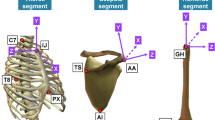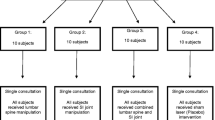Abstract
Purpose
Scapular dyskinesis is a recognized cause of shoulder pain in the throwing shoulder of baseball pitchers and athletes who participate in overhead sports. Past studies have assessed scapular kinematics using electromagnetic tracking devices and have shown a correlation between posterior shoulder tightness and forward scapular posture. The purpose of our study is to evaluate the scapular kinematics, before and after a 4-week posterior stretching protocol in asymptomatic pitchers.
Method
Eleven asymptomatic collegiate baseball pitchers were involved in the study and divided into group A (6 pitchers) underwent 4 weeks of a regimented therapy protocol and group B (5 pitchers) did not receive any treatment. Each pitcher was tested on two separate days: at the first day of the study (S1) and after 4 weeks (S2).
Results
The results demonstrate that there are statistically significant differences in the kinematics of several athletes from the “treated group” (group A) between S1 and S2. It is also important to notice that variations in group A occurred in both flexextension and ab/adduction movements, strengthening the conclusion that the variation was real.
Conclusion
The results of the study can indicate that, in order to prevent the pathologic cascade linked to these sports activities, this physical training protocol might become integral part of the normal daily exercises of baseball pitchers and overhead athletes.
Level of evidence II.


Similar content being viewed by others
References
Myers JB, Laudner KG, Pasquale MR, Bradley JP, Lephart SM (2006) Glenohumeral range of motion deficits and posterior shoulder tightness in throwers with pathologic internal impingement. Am J Sports Med 34(3):385–391
Kibler WB, Chandler TJ, Shapiro R, Conuel M (2007) Muscle activation in coupled scapulohumeral motions in the high performance tennis serve. Br J Sports Med 41(11):745–749
Kibler WB, Sciascia A, Wilkes T (2012) Scapular dyskinesis and its relation to shoulder injury. J Am Acad Orthop Surg. doi:10.5435/JAAOS-20-06-364
Park SS, Loebenberg ML, Rokito AS, Zuckerman JD (2002) The shoulder in baseball pitching: biomechanics and related injuries-part 1. Bull Hosp Jt Dis. 2002–2003;61(1–2):68–79
Burkhart SS, Morgan CD, Kibler WB (2003) The disabled throwing shoulder: spectrum of pathology Part III: the SICK scapula, scapular dyskinesis, the kinetic chain, and rehabilitation. Arthroscopy 19(6):641–661
Burkhart SS, Morgan CD, Kibler WB (2003) The disabled throwing shoulder: spectrum of pathology Part I: pathoanatomy and biomechanics. Arthroscopy 19(4):404–420
McClure P, Balaicuis J, Heiland D, Broersma ME, Thorndike CK, Wood A (2007) A randomized controlled comparison of stretching procedures for posterior shoulder tightness. J Orthop Sports Phys Ther 37(3):108–114
Laudner KG, Sipes RC, Wilson JT (2008) The acute effects of sleeper stretches on shoulder range of motion. J Athl Train. doi:10.4085/1062-6050-43.4.359
Cutti AG, Giovanardi A, Rocchi L, Davalli A, Sacchetti R (2008) Ambulatory measurement of shoulder and elbow kinematics through inertial and magnetic sensors. Med Biol Eng Comput 46(2):169–178
Parel I, Cutti AG, Fiumana G, Porcellini G, Verni G, Accardo AP (2012) Ambulatory measurement of the scapulohumeral rhythm: intra- and inter-operator agreement of a protocol based on inertial and magnetic sensors. Gait Posture. doi:10.1016/j.gaitpost.2011.12.015
Cutti AG, Parel I, Raggi M, Petracci E, Pellegrini A, Accardo AP, Sacchetti R, Porcellini G (2014) Prediction bands and intervals for the scapulo-humeral coordination based on the Bootstrap and two Gaussian methods. J Biomech. doi:10.1016/j.jbiomech.2013.12.028
Kibler WB, McMullen J (2003) Scapular dyskinesis and its relation to shoulder pain. J Am Acad Orthop Surg 11(2):142–151
Bigliani LU, Codd TP, Connor PM, Levine WN, Littlefield MA, Hershon SJ (1997) Shoulder motion and laxity in the professional baseball player. Am J Sports Med 25(5):609–613
Brown LP, Niehues SL, Harrah A, Yavorsky P, Hirshman HP (1988) Upper extremity range of motion and isokinetic strength of the internal and external shoulder rotators in major league baseball players. Am J Sports Med 16(6):577–585
Wilk KE, Meister K, Andrews JR (2002) Current concepts in the rehabilitation of the overhead throwing athlete. Am J Sports Med 30(1):136–151
Jobe FW, Giangarra CE, Kvitne RS, Glousman RE (1991) Anterior capsulolabral reconstruction of the shoulder in athletes in overhand sports. Am J Sports Med 19(5):428–434
Walch G, Boileau P, Noel E, Donell ST (1992) Impingement of the deep surface of the supraspinatus tendon on the posterosuperior glenoid rim: an arthroscopic study. J Shoulder Elbow Surg. doi:10.1016/S1058-2746(09)80065-7
Jobe CM (1995) Posterior superior glenoid impingement: expanded spectrum. Arthroscopy 11(5):530–536
Thomas SJ, Swanik CB, Higginson JS et al (2011) A bilateral comparison of posterior capsule thickness and its correlation with glenohumeral range of motion and scapular upward rotation in collegiate baseball players. J Shoulder Elbow Surg. doi:10.1016/j.jse.2010.08.031
Thomas SJ, Swanik KA, Swanik CB, Kelly JD 4th (2009) Internal rotation deficits affect scapular positioning in baseball players. Clin Orthop Relat Res. doi:10.1007/s11999-009-1124
Clabbers KM, Kelly JD, Bader D et al (2007) Effect of posterior capsule tightness on glenohumeral translation in the late-cocking phase of pitching. J Sport Rehabil 16(1):41–49
Grossman MG, Tibone JE, McGarry MH, Schneider DJ, Veneziani S, Lee TQ (2005) A cadaveric model of the throwing shoulder: a possible etiology of superior labrum anterior-to-posterior lesions. J Bone Joint Surg Am 87(4):824–831
Harryman DT 2nd, Sidles JA, Clark JM, McQuade KJ, Gibb TD, Matsen FA 3rd (1990) Translation of the humeral head on the glenoid with passive glenohumeral motion. J Bone Joint Surg Am 72(9):1334–1343
Huffman GR, Tibone JE, McGarry MH, Phipps BM, Lee YS, Lee TQ (2006) Path of glenohumeral articulation throughout the rotational range of motion in a thrower’s shoulder model. Am J Sports Med 34(10):1662–1669
Laudner KG, Moline MT, Meister K (2010) The relationship between forward scapular posture and posterior shoulder tightness among baseball players. Am J Sports Med. doi:10.1177/0363546510370291
Kibler WB, Sciascia A (2010) Current concepts: scapular dyskinesis. Br J Sports Med. doi:10.1136/bjsm.2009.058834
Pellegrini A, Tonino P, Paladini P, Cutti A, Ceccarelli F, Porcellini G (2013) Motion analysis assessment of alterations in the scapulo-humeral rhythm after throwing in baseball pitchers. Musculoskelet Surg. doi:10.1007/s12306-013-0253-4
Author information
Authors and Affiliations
Corresponding author
Ethics declarations
Conflict of interest
None.
Rights and permissions
About this article
Cite this article
Pellegrini, A., Tonino, P., Salazar, D. et al. Can posterior capsular stretching rehabilitation protocol change scapula kinematics in asymptomatic baseball pitchers?. Musculoskelet Surg 100 (Suppl 1), 39–43 (2016). https://doi.org/10.1007/s12306-016-0416-1
Received:
Accepted:
Published:
Issue Date:
DOI: https://doi.org/10.1007/s12306-016-0416-1




